Develop Workplace: Policy Statement for Energy Conservation in Libraries
VerifiedAdded on 2023/06/11
|10
|1610
|125
AI Summary
This article discusses the policy statement for energy conservation in libraries. It covers key activities, responsibilities, timelines, resources, and training required for the implementation of the policy. The article also suggests ways to reduce the wastage of light in a low-cost manner.
Contribute Materials
Your contribution can guide someone’s learning journey. Share your
documents today.
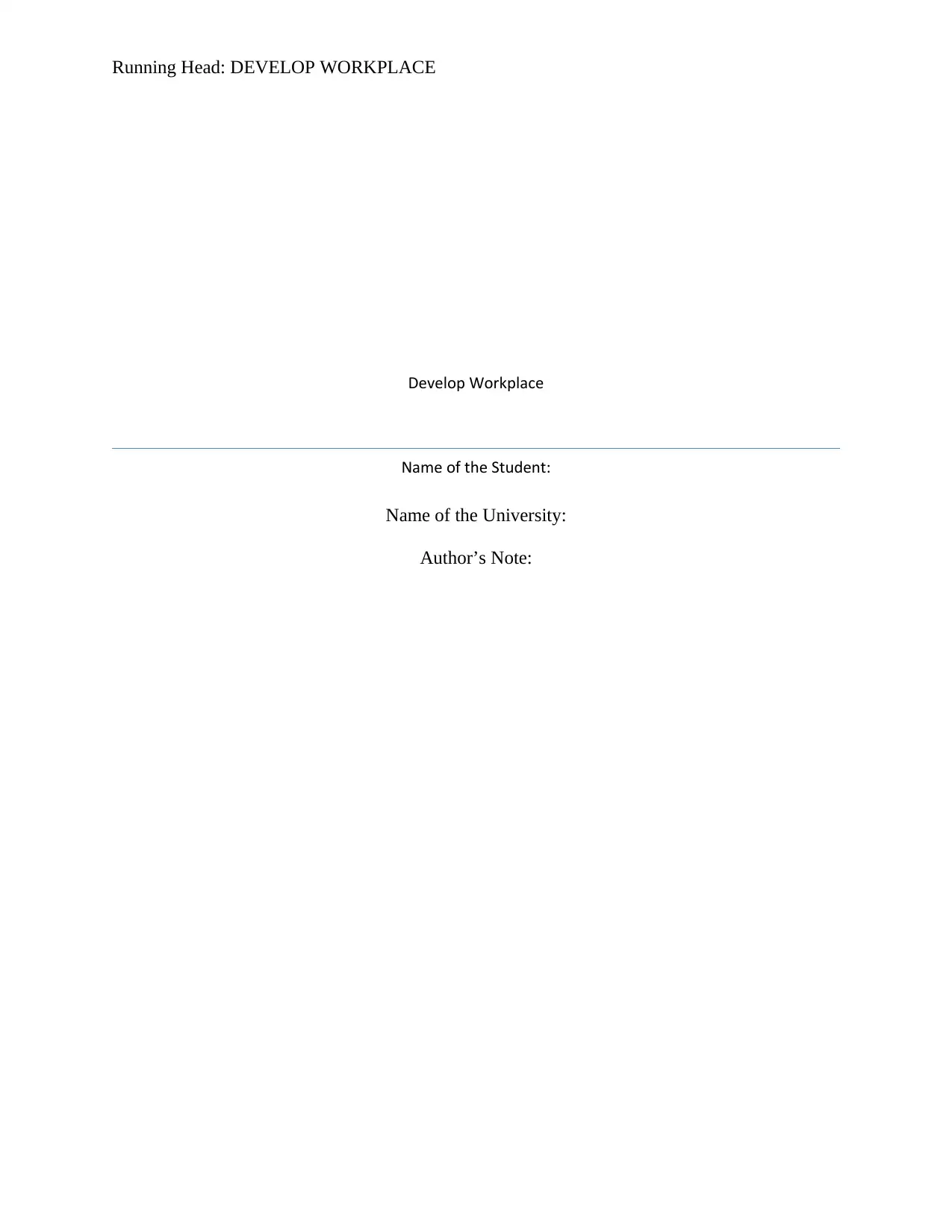
Running Head: DEVELOP WORKPLACE
Develop Workplace
Name of the Student:
Name of the University:
Author’s Note:
Develop Workplace
Name of the Student:
Name of the University:
Author’s Note:
Secure Best Marks with AI Grader
Need help grading? Try our AI Grader for instant feedback on your assignments.
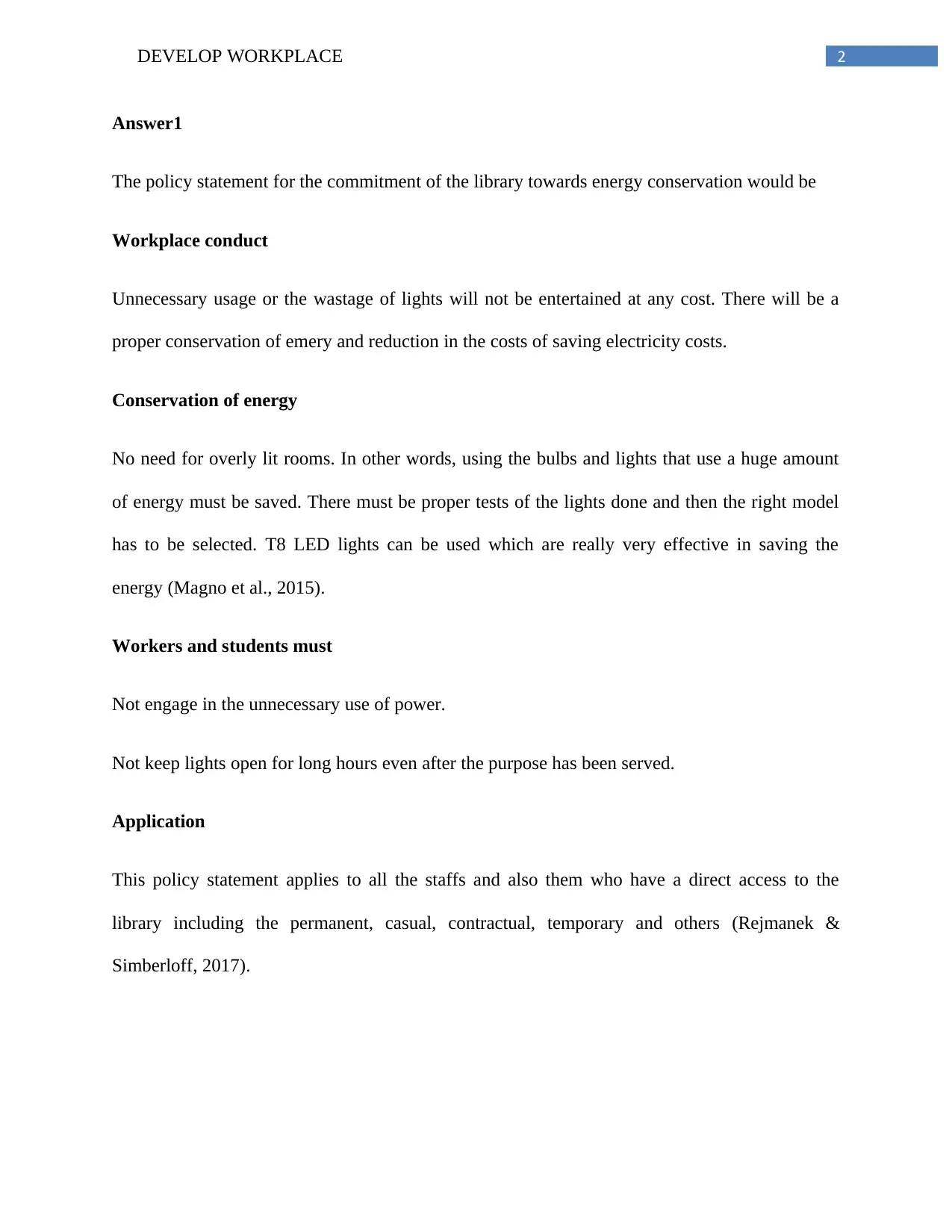
2DEVELOP WORKPLACE
Answer1
The policy statement for the commitment of the library towards energy conservation would be
Workplace conduct
Unnecessary usage or the wastage of lights will not be entertained at any cost. There will be a
proper conservation of emery and reduction in the costs of saving electricity costs.
Conservation of energy
No need for overly lit rooms. In other words, using the bulbs and lights that use a huge amount
of energy must be saved. There must be proper tests of the lights done and then the right model
has to be selected. T8 LED lights can be used which are really very effective in saving the
energy (Magno et al., 2015).
Workers and students must
Not engage in the unnecessary use of power.
Not keep lights open for long hours even after the purpose has been served.
Application
This policy statement applies to all the staffs and also them who have a direct access to the
library including the permanent, casual, contractual, temporary and others (Rejmanek &
Simberloff, 2017).
Answer1
The policy statement for the commitment of the library towards energy conservation would be
Workplace conduct
Unnecessary usage or the wastage of lights will not be entertained at any cost. There will be a
proper conservation of emery and reduction in the costs of saving electricity costs.
Conservation of energy
No need for overly lit rooms. In other words, using the bulbs and lights that use a huge amount
of energy must be saved. There must be proper tests of the lights done and then the right model
has to be selected. T8 LED lights can be used which are really very effective in saving the
energy (Magno et al., 2015).
Workers and students must
Not engage in the unnecessary use of power.
Not keep lights open for long hours even after the purpose has been served.
Application
This policy statement applies to all the staffs and also them who have a direct access to the
library including the permanent, casual, contractual, temporary and others (Rejmanek &
Simberloff, 2017).
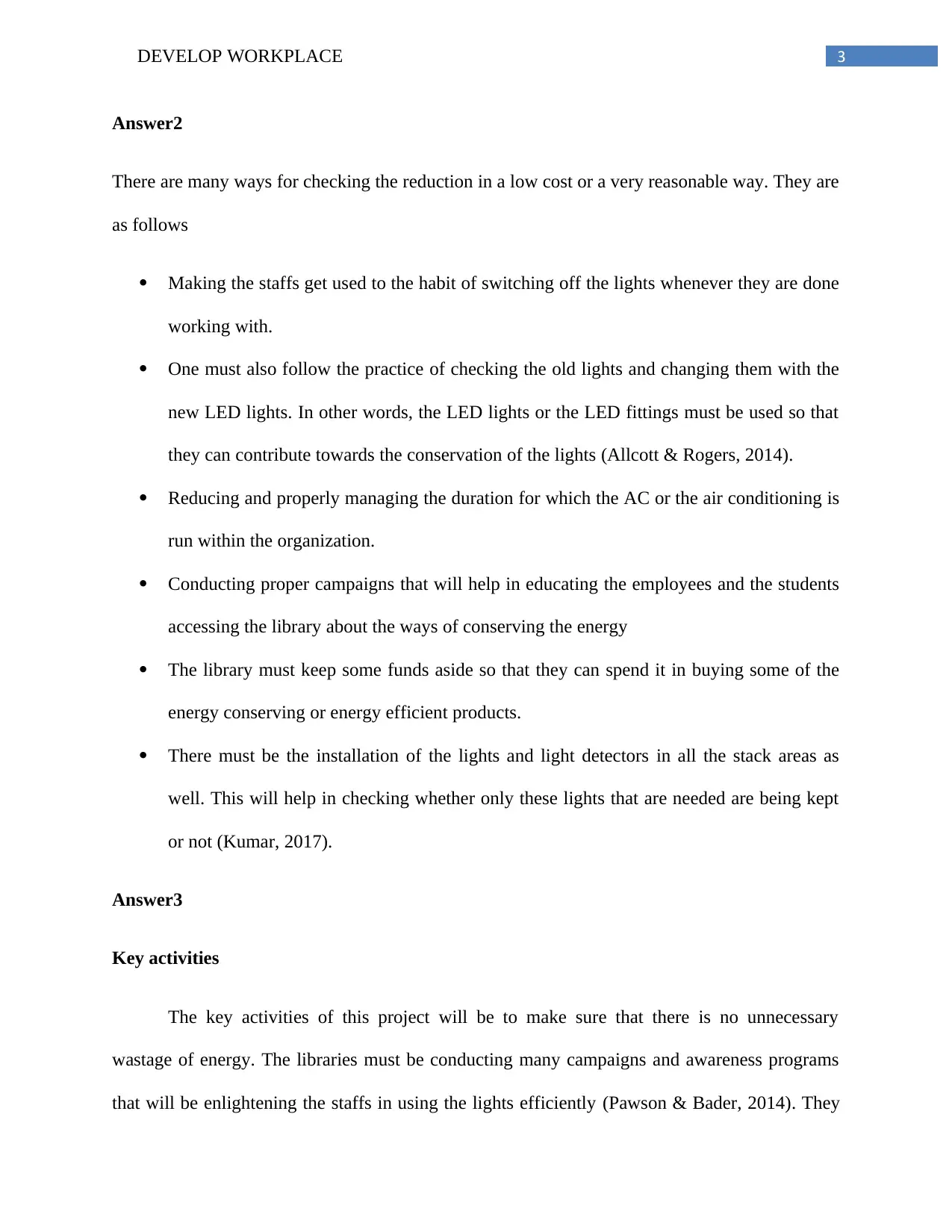
3DEVELOP WORKPLACE
Answer2
There are many ways for checking the reduction in a low cost or a very reasonable way. They are
as follows
Making the staffs get used to the habit of switching off the lights whenever they are done
working with.
One must also follow the practice of checking the old lights and changing them with the
new LED lights. In other words, the LED lights or the LED fittings must be used so that
they can contribute towards the conservation of the lights (Allcott & Rogers, 2014).
Reducing and properly managing the duration for which the AC or the air conditioning is
run within the organization.
Conducting proper campaigns that will help in educating the employees and the students
accessing the library about the ways of conserving the energy
The library must keep some funds aside so that they can spend it in buying some of the
energy conserving or energy efficient products.
There must be the installation of the lights and light detectors in all the stack areas as
well. This will help in checking whether only these lights that are needed are being kept
or not (Kumar, 2017).
Answer3
Key activities
The key activities of this project will be to make sure that there is no unnecessary
wastage of energy. The libraries must be conducting many campaigns and awareness programs
that will be enlightening the staffs in using the lights efficiently (Pawson & Bader, 2014). They
Answer2
There are many ways for checking the reduction in a low cost or a very reasonable way. They are
as follows
Making the staffs get used to the habit of switching off the lights whenever they are done
working with.
One must also follow the practice of checking the old lights and changing them with the
new LED lights. In other words, the LED lights or the LED fittings must be used so that
they can contribute towards the conservation of the lights (Allcott & Rogers, 2014).
Reducing and properly managing the duration for which the AC or the air conditioning is
run within the organization.
Conducting proper campaigns that will help in educating the employees and the students
accessing the library about the ways of conserving the energy
The library must keep some funds aside so that they can spend it in buying some of the
energy conserving or energy efficient products.
There must be the installation of the lights and light detectors in all the stack areas as
well. This will help in checking whether only these lights that are needed are being kept
or not (Kumar, 2017).
Answer3
Key activities
The key activities of this project will be to make sure that there is no unnecessary
wastage of energy. The libraries must be conducting many campaigns and awareness programs
that will be enlightening the staffs in using the lights efficiently (Pawson & Bader, 2014). They
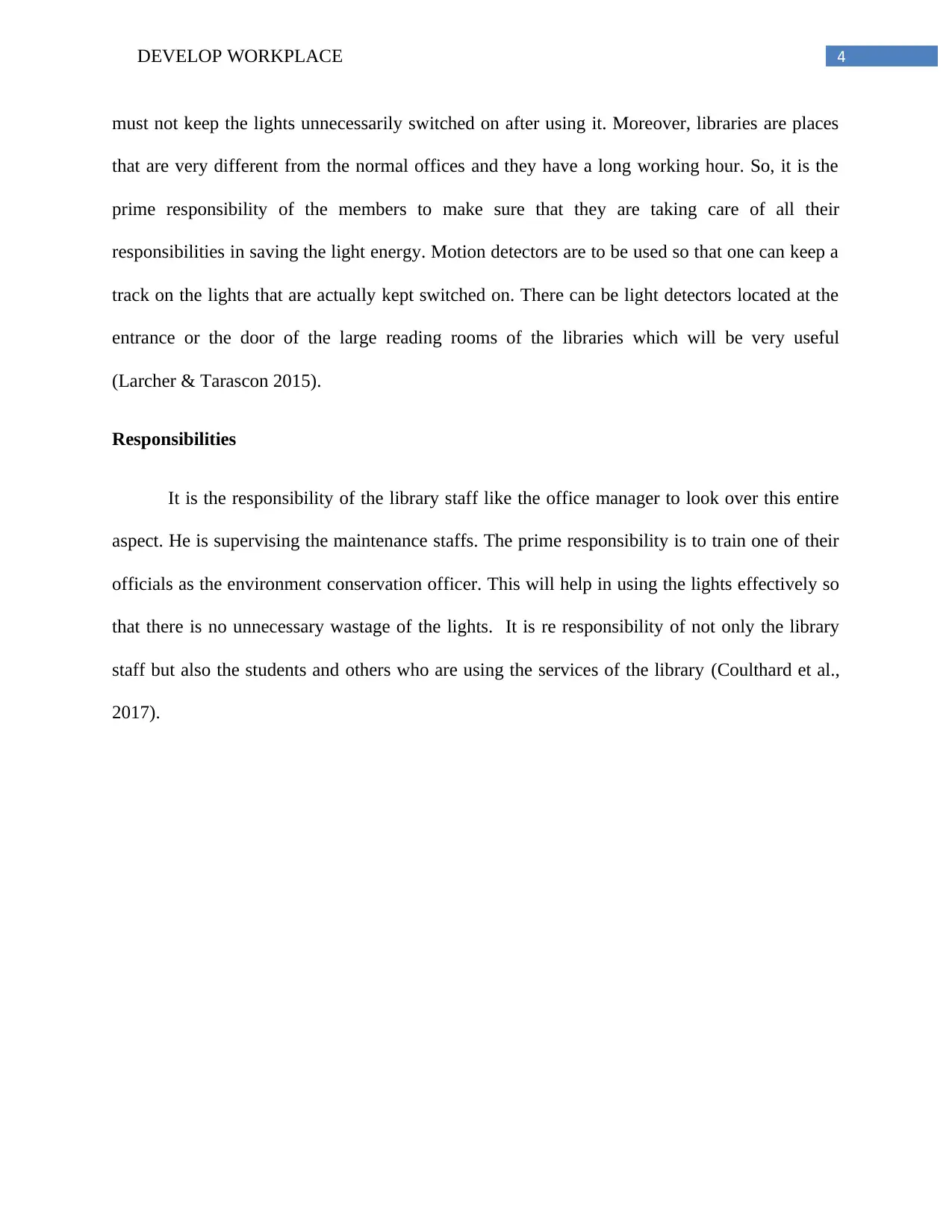
4DEVELOP WORKPLACE
must not keep the lights unnecessarily switched on after using it. Moreover, libraries are places
that are very different from the normal offices and they have a long working hour. So, it is the
prime responsibility of the members to make sure that they are taking care of all their
responsibilities in saving the light energy. Motion detectors are to be used so that one can keep a
track on the lights that are actually kept switched on. There can be light detectors located at the
entrance or the door of the large reading rooms of the libraries which will be very useful
(Larcher & Tarascon 2015).
Responsibilities
It is the responsibility of the library staff like the office manager to look over this entire
aspect. He is supervising the maintenance staffs. The prime responsibility is to train one of their
officials as the environment conservation officer. This will help in using the lights effectively so
that there is no unnecessary wastage of the lights. It is re responsibility of not only the library
staff but also the students and others who are using the services of the library (Coulthard et al.,
2017).
must not keep the lights unnecessarily switched on after using it. Moreover, libraries are places
that are very different from the normal offices and they have a long working hour. So, it is the
prime responsibility of the members to make sure that they are taking care of all their
responsibilities in saving the light energy. Motion detectors are to be used so that one can keep a
track on the lights that are actually kept switched on. There can be light detectors located at the
entrance or the door of the large reading rooms of the libraries which will be very useful
(Larcher & Tarascon 2015).
Responsibilities
It is the responsibility of the library staff like the office manager to look over this entire
aspect. He is supervising the maintenance staffs. The prime responsibility is to train one of their
officials as the environment conservation officer. This will help in using the lights effectively so
that there is no unnecessary wastage of the lights. It is re responsibility of not only the library
staff but also the students and others who are using the services of the library (Coulthard et al.,
2017).
Secure Best Marks with AI Grader
Need help grading? Try our AI Grader for instant feedback on your assignments.
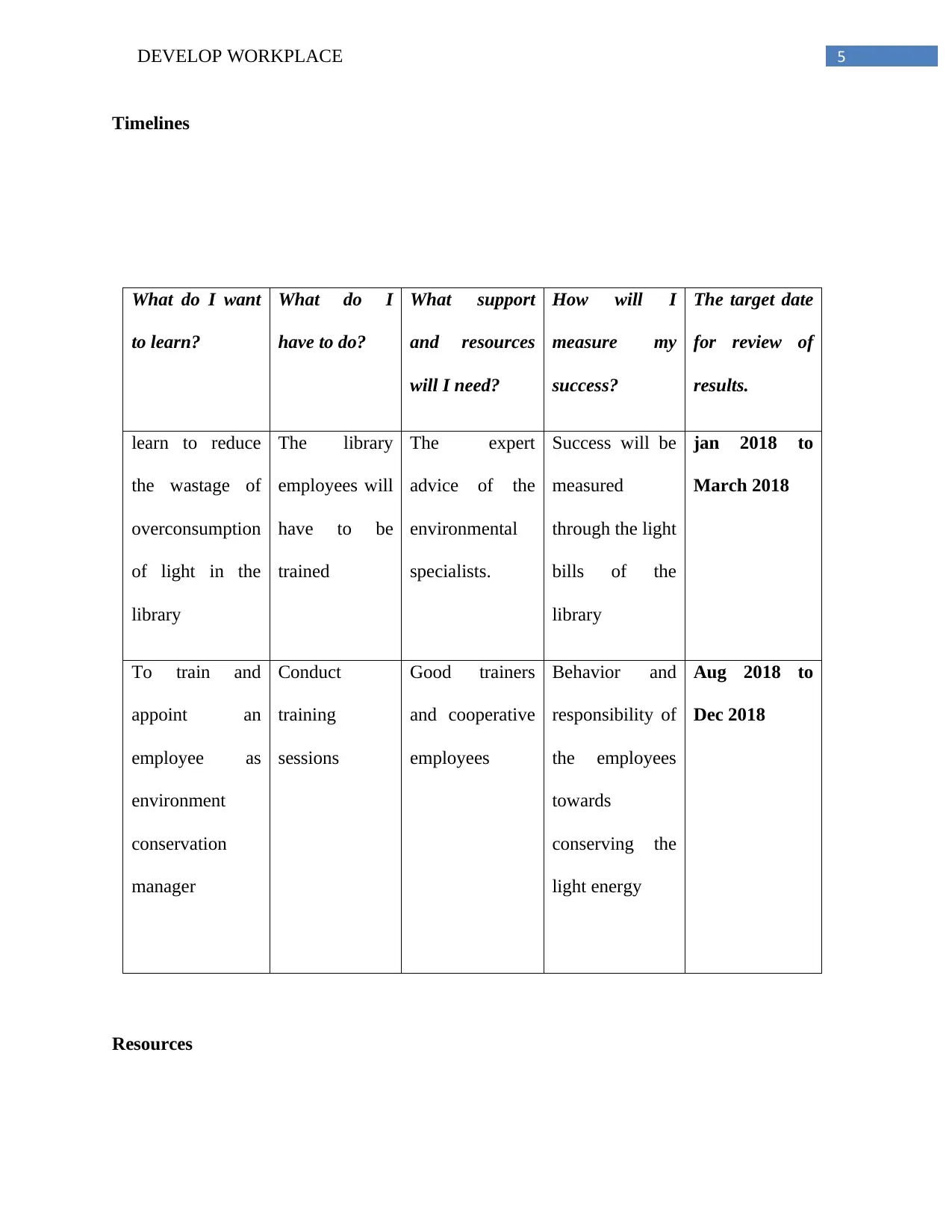
5DEVELOP WORKPLACE
Timelines
What do I want
to learn?
What do I
have to do?
What support
and resources
will I need?
How will I
measure my
success?
The target date
for review of
results.
learn to reduce
the wastage of
overconsumption
of light in the
library
The library
employees will
have to be
trained
The expert
advice of the
environmental
specialists.
Success will be
measured
through the light
bills of the
library
jan 2018 to
March 2018
To train and
appoint an
employee as
environment
conservation
manager
Conduct
training
sessions
Good trainers
and cooperative
employees
Behavior and
responsibility of
the employees
towards
conserving the
light energy
Aug 2018 to
Dec 2018
Resources
Timelines
What do I want
to learn?
What do I
have to do?
What support
and resources
will I need?
How will I
measure my
success?
The target date
for review of
results.
learn to reduce
the wastage of
overconsumption
of light in the
library
The library
employees will
have to be
trained
The expert
advice of the
environmental
specialists.
Success will be
measured
through the light
bills of the
library
jan 2018 to
March 2018
To train and
appoint an
employee as
environment
conservation
manager
Conduct
training
sessions
Good trainers
and cooperative
employees
Behavior and
responsibility of
the employees
towards
conserving the
light energy
Aug 2018 to
Dec 2018
Resources
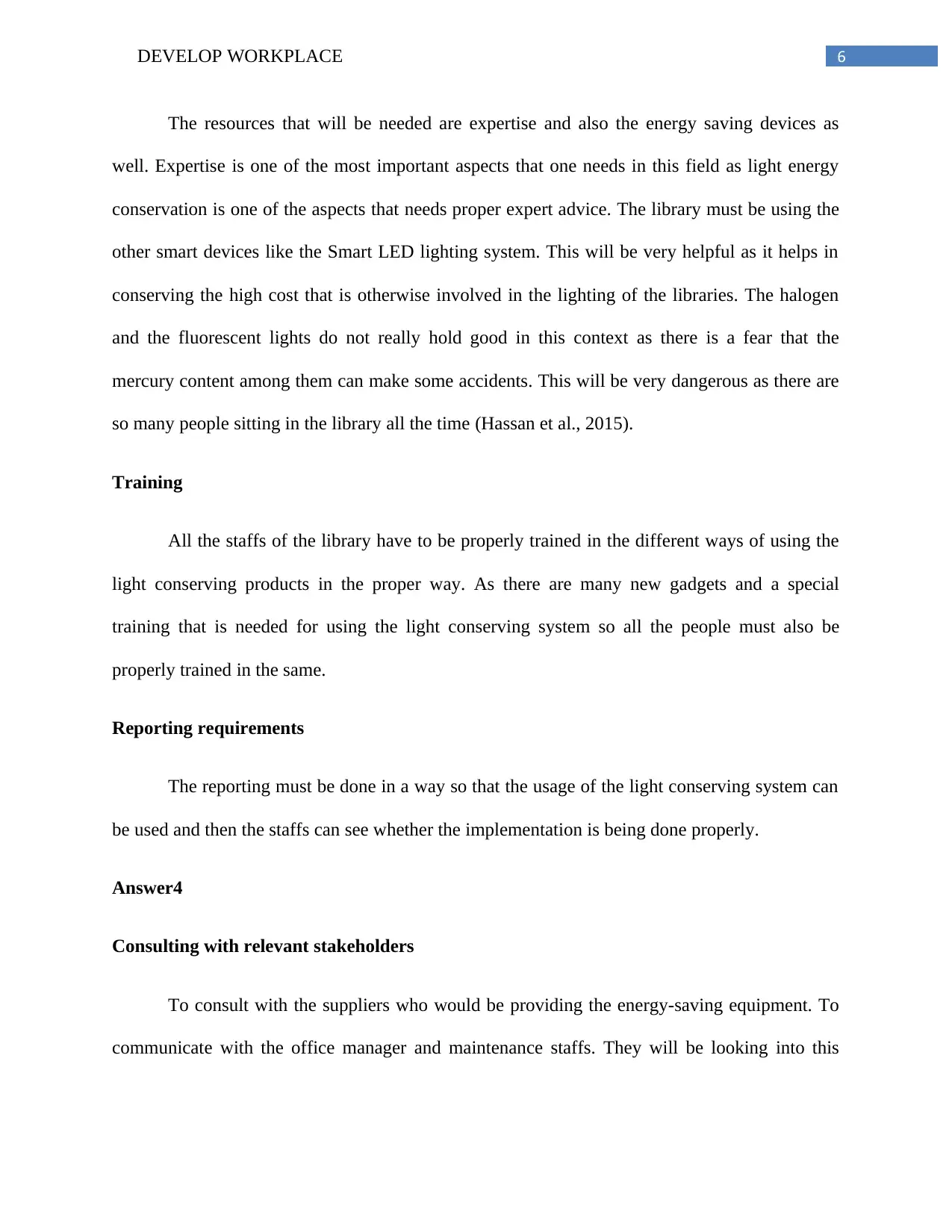
6DEVELOP WORKPLACE
The resources that will be needed are expertise and also the energy saving devices as
well. Expertise is one of the most important aspects that one needs in this field as light energy
conservation is one of the aspects that needs proper expert advice. The library must be using the
other smart devices like the Smart LED lighting system. This will be very helpful as it helps in
conserving the high cost that is otherwise involved in the lighting of the libraries. The halogen
and the fluorescent lights do not really hold good in this context as there is a fear that the
mercury content among them can make some accidents. This will be very dangerous as there are
so many people sitting in the library all the time (Hassan et al., 2015).
Training
All the staffs of the library have to be properly trained in the different ways of using the
light conserving products in the proper way. As there are many new gadgets and a special
training that is needed for using the light conserving system so all the people must also be
properly trained in the same.
Reporting requirements
The reporting must be done in a way so that the usage of the light conserving system can
be used and then the staffs can see whether the implementation is being done properly.
Answer4
Consulting with relevant stakeholders
To consult with the suppliers who would be providing the energy-saving equipment. To
communicate with the office manager and maintenance staffs. They will be looking into this
The resources that will be needed are expertise and also the energy saving devices as
well. Expertise is one of the most important aspects that one needs in this field as light energy
conservation is one of the aspects that needs proper expert advice. The library must be using the
other smart devices like the Smart LED lighting system. This will be very helpful as it helps in
conserving the high cost that is otherwise involved in the lighting of the libraries. The halogen
and the fluorescent lights do not really hold good in this context as there is a fear that the
mercury content among them can make some accidents. This will be very dangerous as there are
so many people sitting in the library all the time (Hassan et al., 2015).
Training
All the staffs of the library have to be properly trained in the different ways of using the
light conserving products in the proper way. As there are many new gadgets and a special
training that is needed for using the light conserving system so all the people must also be
properly trained in the same.
Reporting requirements
The reporting must be done in a way so that the usage of the light conserving system can
be used and then the staffs can see whether the implementation is being done properly.
Answer4
Consulting with relevant stakeholders
To consult with the suppliers who would be providing the energy-saving equipment. To
communicate with the office manager and maintenance staffs. They will be looking into this

7DEVELOP WORKPLACE
matter and looking after the installation and the usage of all these light conserving resources
(Rejmanek & Simberloff, 2017).
matter and looking after the installation and the usage of all these light conserving resources
(Rejmanek & Simberloff, 2017).
Paraphrase This Document
Need a fresh take? Get an instant paraphrase of this document with our AI Paraphraser
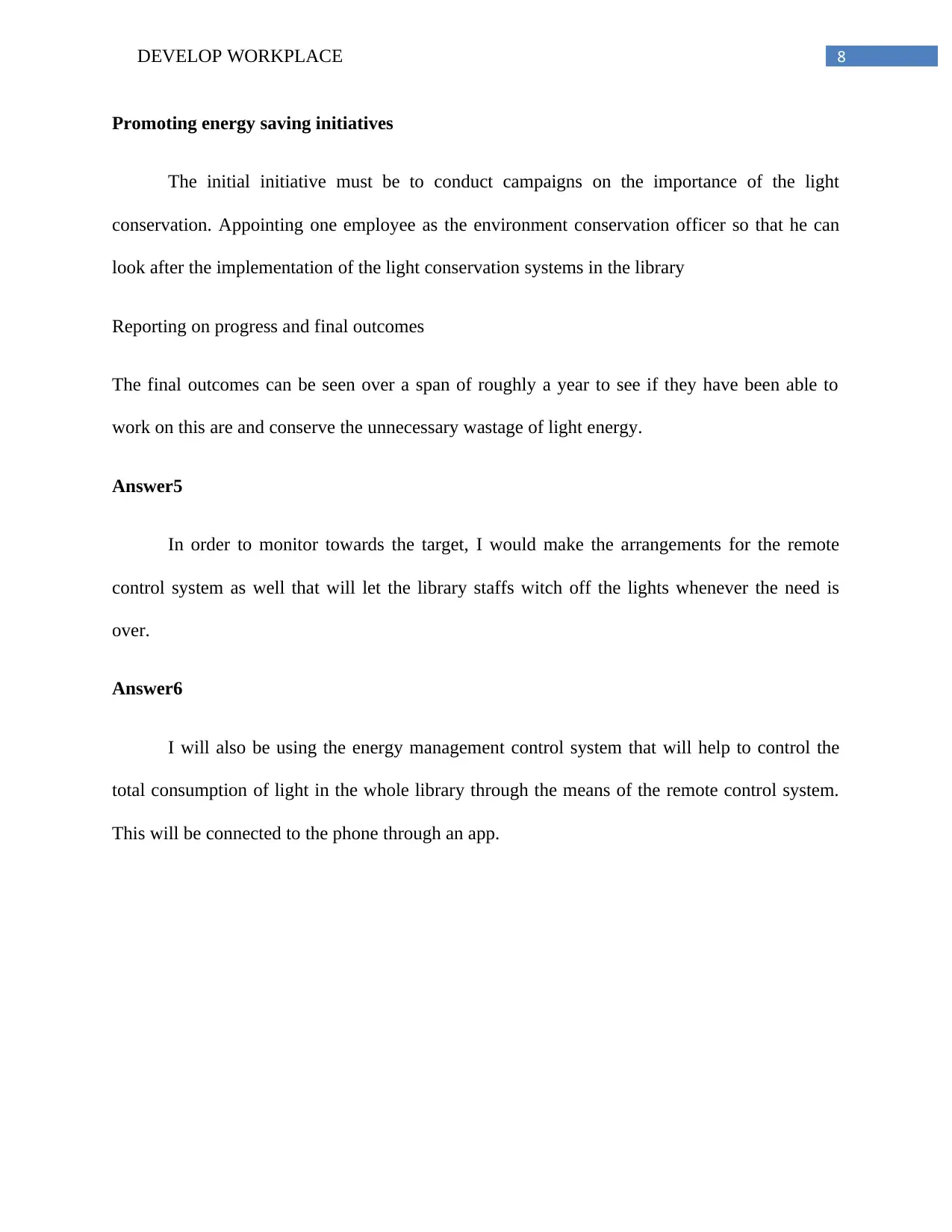
8DEVELOP WORKPLACE
Promoting energy saving initiatives
The initial initiative must be to conduct campaigns on the importance of the light
conservation. Appointing one employee as the environment conservation officer so that he can
look after the implementation of the light conservation systems in the library
Reporting on progress and final outcomes
The final outcomes can be seen over a span of roughly a year to see if they have been able to
work on this are and conserve the unnecessary wastage of light energy.
Answer5
In order to monitor towards the target, I would make the arrangements for the remote
control system as well that will let the library staffs witch off the lights whenever the need is
over.
Answer6
I will also be using the energy management control system that will help to control the
total consumption of light in the whole library through the means of the remote control system.
This will be connected to the phone through an app.
Promoting energy saving initiatives
The initial initiative must be to conduct campaigns on the importance of the light
conservation. Appointing one employee as the environment conservation officer so that he can
look after the implementation of the light conservation systems in the library
Reporting on progress and final outcomes
The final outcomes can be seen over a span of roughly a year to see if they have been able to
work on this are and conserve the unnecessary wastage of light energy.
Answer5
In order to monitor towards the target, I would make the arrangements for the remote
control system as well that will let the library staffs witch off the lights whenever the need is
over.
Answer6
I will also be using the energy management control system that will help to control the
total consumption of light in the whole library through the means of the remote control system.
This will be connected to the phone through an app.
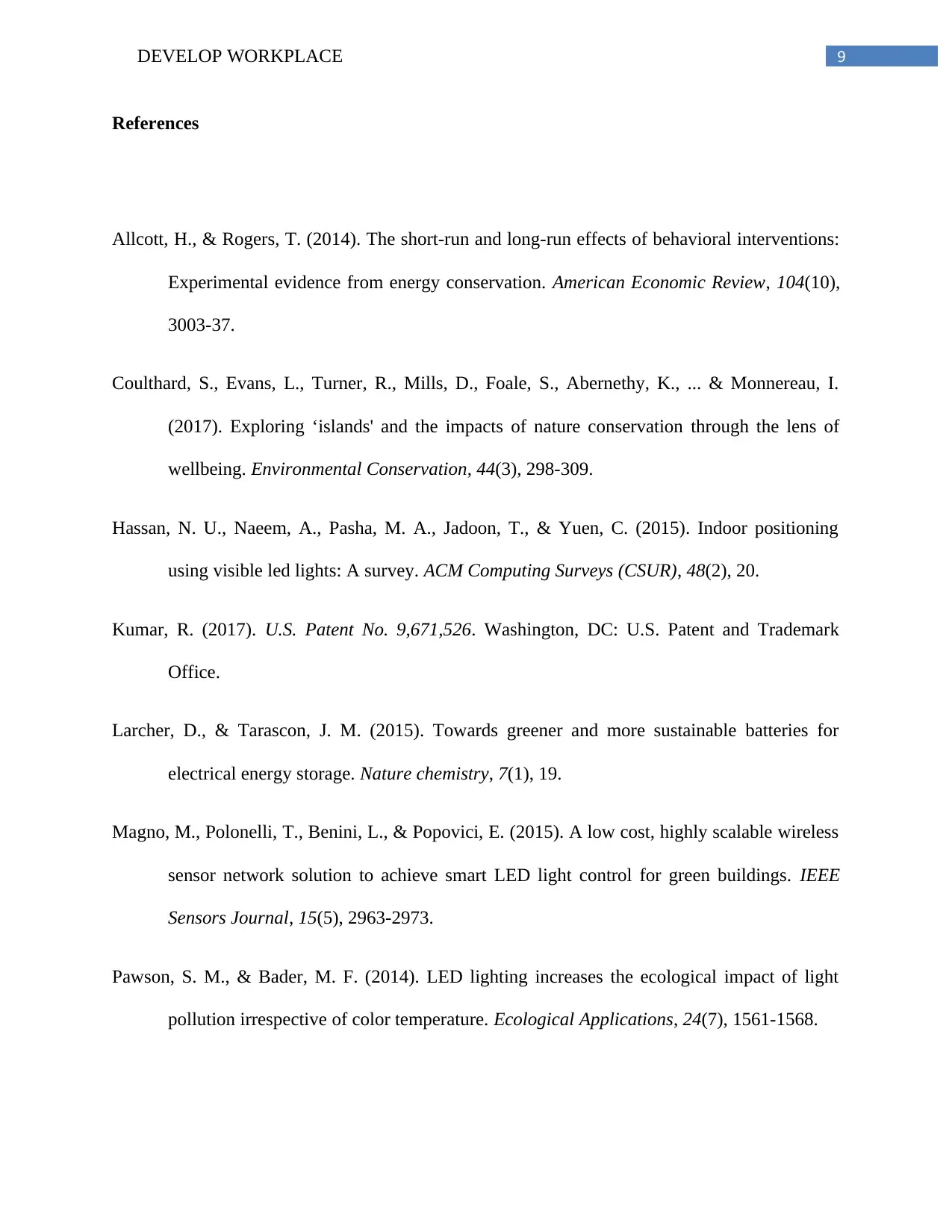
9DEVELOP WORKPLACE
References
Allcott, H., & Rogers, T. (2014). The short-run and long-run effects of behavioral interventions:
Experimental evidence from energy conservation. American Economic Review, 104(10),
3003-37.
Coulthard, S., Evans, L., Turner, R., Mills, D., Foale, S., Abernethy, K., ... & Monnereau, I.
(2017). Exploring ‘islands' and the impacts of nature conservation through the lens of
wellbeing. Environmental Conservation, 44(3), 298-309.
Hassan, N. U., Naeem, A., Pasha, M. A., Jadoon, T., & Yuen, C. (2015). Indoor positioning
using visible led lights: A survey. ACM Computing Surveys (CSUR), 48(2), 20.
Kumar, R. (2017). U.S. Patent No. 9,671,526. Washington, DC: U.S. Patent and Trademark
Office.
Larcher, D., & Tarascon, J. M. (2015). Towards greener and more sustainable batteries for
electrical energy storage. Nature chemistry, 7(1), 19.
Magno, M., Polonelli, T., Benini, L., & Popovici, E. (2015). A low cost, highly scalable wireless
sensor network solution to achieve smart LED light control for green buildings. IEEE
Sensors Journal, 15(5), 2963-2973.
Pawson, S. M., & Bader, M. F. (2014). LED lighting increases the ecological impact of light
pollution irrespective of color temperature. Ecological Applications, 24(7), 1561-1568.
References
Allcott, H., & Rogers, T. (2014). The short-run and long-run effects of behavioral interventions:
Experimental evidence from energy conservation. American Economic Review, 104(10),
3003-37.
Coulthard, S., Evans, L., Turner, R., Mills, D., Foale, S., Abernethy, K., ... & Monnereau, I.
(2017). Exploring ‘islands' and the impacts of nature conservation through the lens of
wellbeing. Environmental Conservation, 44(3), 298-309.
Hassan, N. U., Naeem, A., Pasha, M. A., Jadoon, T., & Yuen, C. (2015). Indoor positioning
using visible led lights: A survey. ACM Computing Surveys (CSUR), 48(2), 20.
Kumar, R. (2017). U.S. Patent No. 9,671,526. Washington, DC: U.S. Patent and Trademark
Office.
Larcher, D., & Tarascon, J. M. (2015). Towards greener and more sustainable batteries for
electrical energy storage. Nature chemistry, 7(1), 19.
Magno, M., Polonelli, T., Benini, L., & Popovici, E. (2015). A low cost, highly scalable wireless
sensor network solution to achieve smart LED light control for green buildings. IEEE
Sensors Journal, 15(5), 2963-2973.
Pawson, S. M., & Bader, M. F. (2014). LED lighting increases the ecological impact of light
pollution irrespective of color temperature. Ecological Applications, 24(7), 1561-1568.

10DEVELOP WORKPLACE
Rejmanek, M., & Simberloff, D. (2017). Origin matters. Environmental Conservation, 44(2), 97-
99.
Rejmanek, M., & Simberloff, D. (2017). Origin matters. Environmental Conservation, 44(2), 97-
99.
1 out of 10
Related Documents
Your All-in-One AI-Powered Toolkit for Academic Success.
+13062052269
info@desklib.com
Available 24*7 on WhatsApp / Email
![[object Object]](/_next/static/media/star-bottom.7253800d.svg)
Unlock your academic potential
© 2024 | Zucol Services PVT LTD | All rights reserved.




